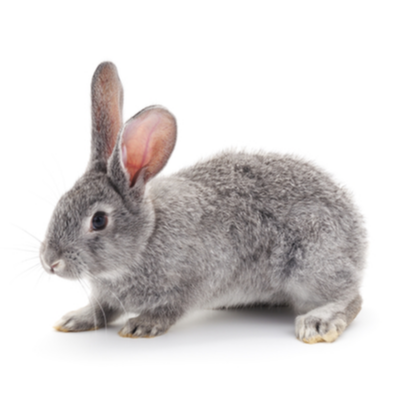
Wild rabbits prosper in a variety of habitats, where an abundance of natural cover to hide, nest and eat is available. Cottontails are most active at dawn and dusk.
Wild rabbits are herbivores. Their diet is 90% grass, but they'll eat almost any type of vegetable in the summer.
Grasses, broadleaf weeds, garden crops, beans, peas, cabbage and lettuce are all favorites. In the winter wild rabbits will eat tree buds, twigs and bark.
Wild rabbits can do considerable damage to flowers, vegetables, trees and shrubs any time of the year, especially in places such as suburban yards, rural fields and tree plantations.
Wild rabbits will eat your precious flowers and vegetables and can damage trees and shrubs by clipping stems, buds and small branches and by girdling larger trees.
Habitat Modification
- Remove brushy and weedy habitat.
- An 18-inch high fence can exclude cottontails from small areas. Fences need to be high and maintained through winter and early spring.
- On individual plants, use 1-inch or less mesh.
- Most domestic dogs can discourage rabbits.
- Wrap Individual plants with plastics, papers, metals, nettings that wrap individual plants.
- Rabbit Exclusion
Rabbit Exclusion:
- Fencing is an effective option for all critters who venture where they are not wanted. Putting up chicken wire or hardware cloth gets the job done.
- Be sure to place it two to three feet high (so a rabbit standing on its hind legs cannot reach the plant being protected) and bury it two to three inches into the ground.
Manufacturer Recommended Products And Treatment For Aphids Control
Pests need food, water, and shelter. Often the problem may be solved just by removing these key items. Before even thinking about chemical pest control, it is important to be aware of
| Conducive Condition | Recommendation | |
| 1 | Tree branches on house | Keep tree branches away from house to reduce pest access |
| 2 | Firewood next to foundation | Keep firewood away from house to reduce pest harborage |
| 3 | Debris on crawlspace/next to foundation | Remove wood debris to reduce termite ha rborage area |
| 4 | Excessive plant cover, stump, etc. | Providing spacing between plant cover and structure |
| 5 | Soil above the foundation Ii ne | Keep soil below top of foundation to reduce harbo rage areas |
| 6 | Wood-to-ground contact | Keep soil from touching wood to eliminate termite access |
| 7 | Debris on roof/full gutter | Keep gutter & roof free of debris to reduce insect harborage |
| 8 | Standi ng water near/under structure | Eli minate standing water to reduce pest harbo rage |
| 9 | Mo isture problem under structure | Increase ventilation to reduce pest harbo rage area |
| 10 | Openi ngs at plumbi ng & electronics | Seal opening to reduce pest access |
| 11 | Excessive gaps at windows/doors | Seal gaps to reduce pest access |
| 12 | Lea ky plumb ing fixtures | Repair to reduce moisture for pests |
| 13 | Keep garbage cans covered | Covered to reduce attraction of insects of vertebrate pests |
| 14 | Mo isture damage wood | Repair rotten or damaged wood to reduce insect harborage |
| 15 | Grocery bags stored improperly | Seal paper sacks in containers to reduce i nsect ha rborage areas |
| 16 | Pet food unsealed or left out | Keep pet food in sealed containers and unavailable to pests |
| 17 | Excessive storage conditions | Keep storage areas uncluttered and manageable |
| 18 | Debris below kick plates | Remove kick plates to reduce rodent harborage |
2 products



